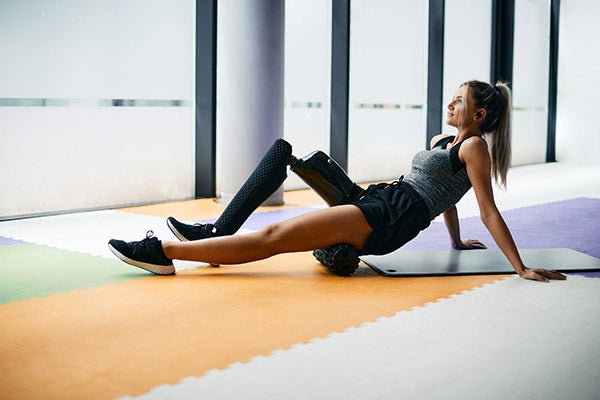
Limb loss comes with a vocabulary all its own. A term that gets tossed around—K-level—affects your medical coverage and access to different kinds of prostheses. However, K-level parameters aren’t as cut and dry as many people may think. A better understanding of K-levels can help focus your exercise, physical therapy, and goals so that you can have the active lifestyle of your choosing.
We’ve tapped the expertise of Greg Mannino, prosthetist and 22x Paralympic champion, and Cosi Belloso, MPT, a physical therapist who specializes in limb loss. We’ll cover the basics here, but if you want more in-depth information, check out VitalFit’s online webinar from Nov. 30, 2021, The Language of Limb Loss Part II.
What are K-levels?
K-levels are a rating system used by Medicare to determine the components and prostheses types that are available to lower limb amputees. K-levels do not apply to upper limb amputations. A physician or clinician performs an assessment or series of assessments to determine your K-level. The abbreviated definitions are as follows:
K0
The person cannot ambulate or transfer safely with or without assistance. A prosthesis would not enhance mobility or quality of life.
K1

There’s potential or the ability for transfers or ambulation using a prosthesis on level surfaces at a fixed speed or cadence—for example, someone who only walks within the confines of their own home.
K2
A person that’s defined as K2 has the ability or potential to move over low-level barriers, like stairs, uneven surfaces, or curbs. At this level, the person can navigate outside the home but may have trouble in crowded spaces.
K3

At the K3 level, the person can move at varying speeds and cadences. They can navigate most barriers, and they may need a special prosthetic for work, therapeutic, or exercise activities that go beyond walking.
K4
K4 level people have the ability or potential to go beyond basic movement with a prosthetic and do high impact, high stress, and high energy level activities. Children, athletes, and active adults often meet these criteria.
Can I change my K-level?
The short answer is often yes, but it depends on the nature of your limb loss and medical condition. “Understanding the levels as a user is important to your rehab,” explains Mannino. However, try not to get discouraged if you’re currently not at the K-level that you’d like. Both Belloso and Mannino have had patients who are disappointed with their K-level who have successfully changed their classification.
Belloso says that she uses areas within the tests and assessments used for K-level classification to build a physical therapy program to help patients meet their specific goals. You can set physical therapy goals based on areas or points of weakness that will allow you to change your K-level and gain access to different prostheses.
Both Mannino and Belloso stress the importance of determining not just what you can do now but what kind of activities in which you want to participate in the near future. That can help determine the right physical therapy program so you can have the skills to reach the K-level (and prosthesis that come with it) that you want.
“Practicing in physical therapy [and at home] can change things pretty quickly,” Mannino explains. With hard work, many people can change their K-level within a matter of months.
What can I do to change my K-level
The first step is to talk to your medical team—your doctor, physical therapist, prosthetist, and others. Any of these professionals can point you in the right direction toward changing your mobility and, eventually, your K-level. A few tips as you’re working toward your goal:

- Stay active. Muscles weaken and stiffen without regular use. Try to be as mobile as your limb loss allows.
- Follow through. If your doctor or physical therapist gives you exercises to do at home, do them. Consistency builds strength, flexibility, balance, and the confidence you need for greater mobility.
- Take care of your skin. The skin on your residual can become irritated as you take on more challenging movement patterns. Wash it every day with a gentle cleanser. Moisturize the skin so that it stays strong and flexible. Protect the skin from chafing by using a product like VitalFit’s Liquid-to-Powder Plus.
- Prepare for your classification test. “When you go in for your classification, eat healthy, hydrate, and get ready for the best workout of your life,” says Mannino. Don’t forget to get plenty of rest the night before.
Final Thoughts
Getting a classification that’s lower than you want can be disappointing. However, most people have the ability to improve their balance, strength, and mobility with practice. Stay active and set goals that move you closer to or keep you fit for your lifestyle.
